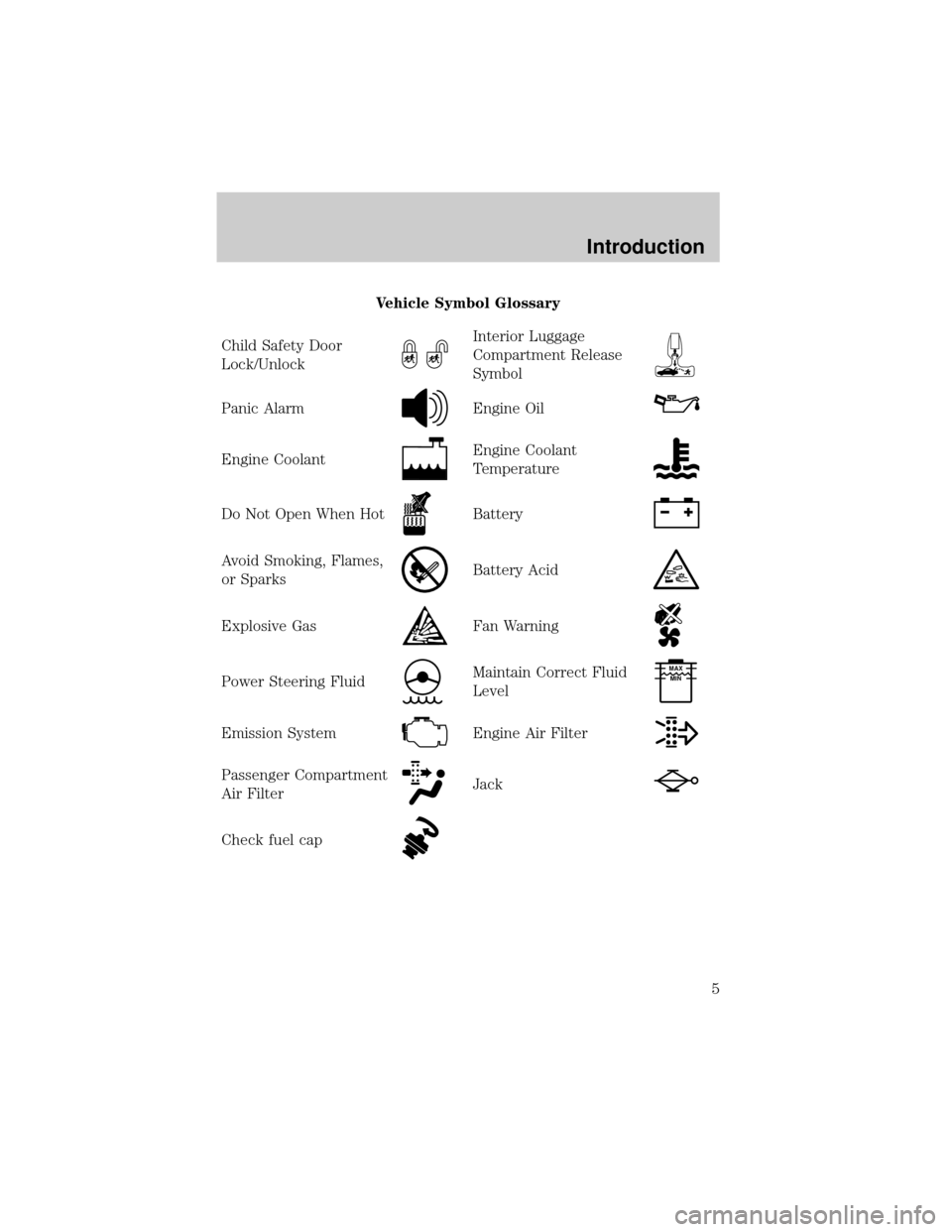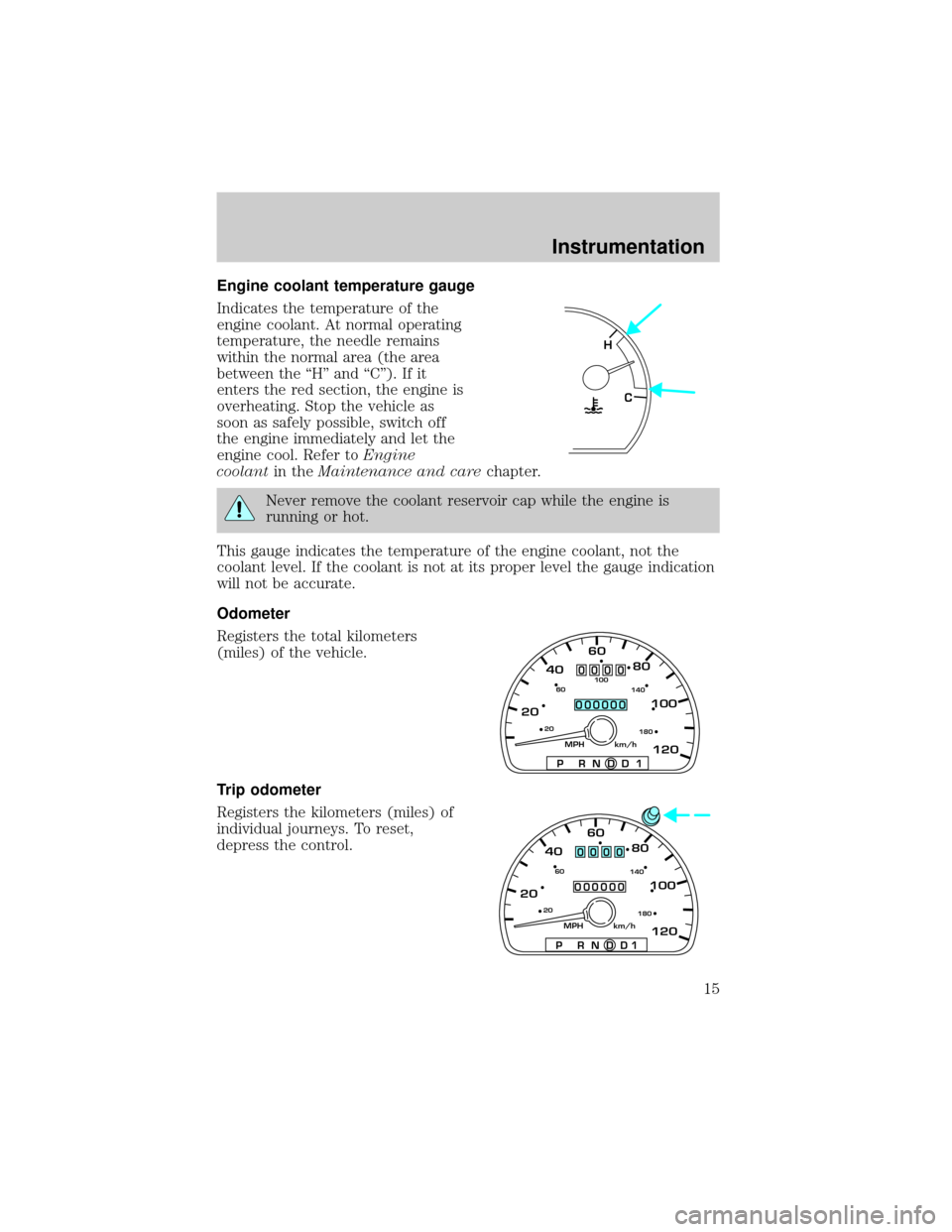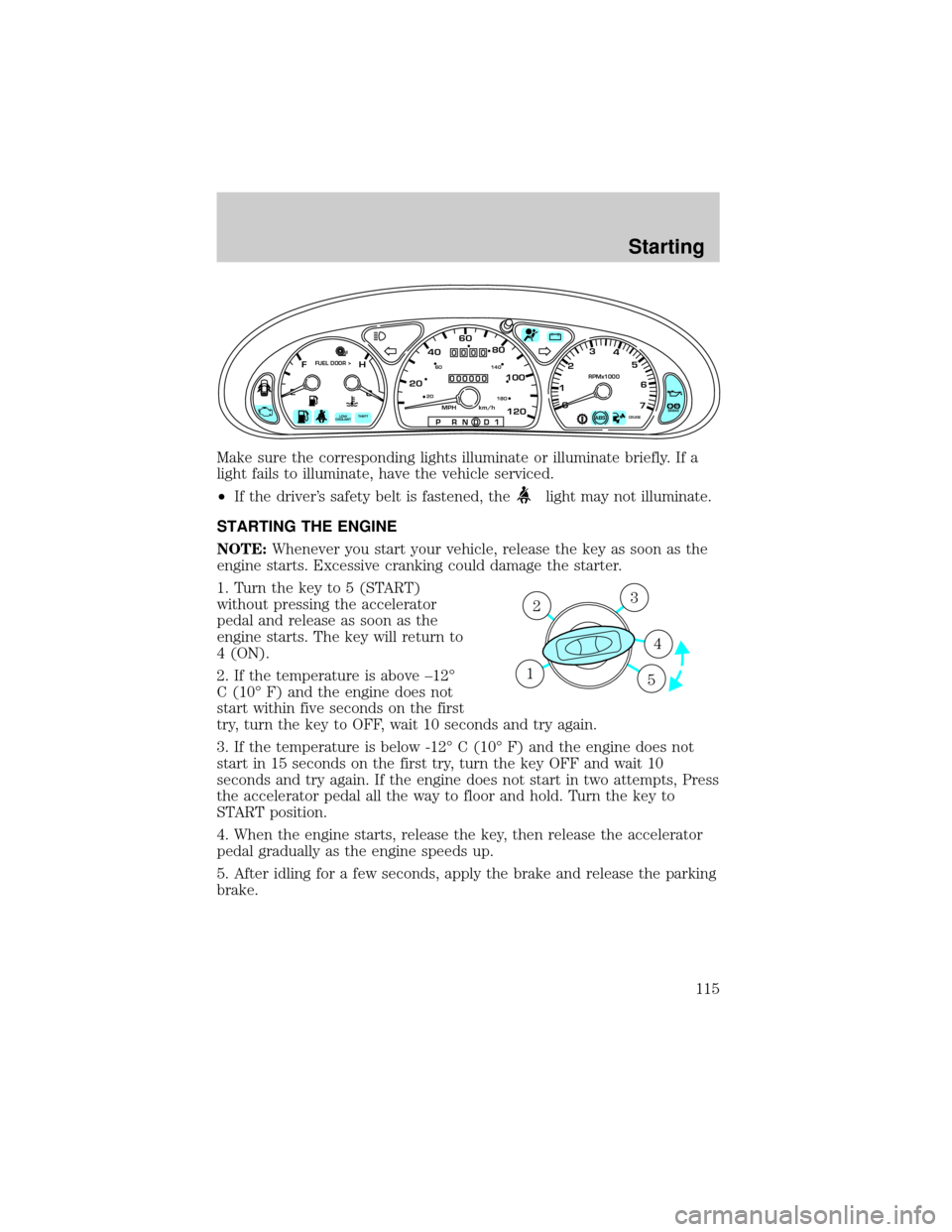coolant temperature Mercury Sable 2001 Owner's Manuals
[x] Cancel search | Manufacturer: MERCURY, Model Year: 2001, Model line: Sable, Model: Mercury Sable 2001Pages: 240, PDF Size: 2.22 MB
Page 5 of 240

Vehicle Symbol Glossary
Child Safety Door
Lock/Unlock
Interior Luggage
Compartment Release
Symbol
Panic AlarmEngine Oil
Engine CoolantEngine Coolant
Temperature
Do Not Open When HotBattery
Avoid Smoking, Flames,
or SparksBattery Acid
Explosive GasFan Warning
Power Steering FluidMaintain Correct Fluid
LevelMAX
MIN
Emission SystemEngine Air Filter
Passenger Compartment
Air FilterJack
Check fuel cap
Introduction
5
Page 15 of 240

Engine coolant temperature gauge
Indicates the temperature of the
engine coolant. At normal operating
temperature, the needle remains
within the normal area (the area
between the ªHº and ªCº). If it
enters the red section, the engine is
overheating. Stop the vehicle as
soon as safely possible, switch off
the engine immediately and let the
engine cool. Refer toEngine
coolantin theMaintenance and carechapter.
Never remove the coolant reservoir cap while the engine is
running or hot.
This gauge indicates the temperature of the engine coolant, not the
coolant level. If the coolant is not at its proper level the gauge indication
will not be accurate.
Odometer
Registers the total kilometers
(miles) of the vehicle.
Trip odometer
Registers the kilometers (miles) of
individual journeys. To reset,
depress the control.
C H
204060
80
100
1202060
140 100
180
P R N D D 1
MPH km/h
000000
0000
204060
80
100
1202060
140
180
P R N D D 1
MPH km/h
000000
0 000
Instrumentation
15
Page 115 of 240

Make sure the corresponding lights illuminate or illuminate briefly. If a
light fails to illuminate, have the vehicle serviced.
²If the driver's safety belt is fastened, the
light may not illuminate.
STARTING THE ENGINE
NOTE:Whenever you start your vehicle, release the key as soon as the
engine starts. Excessive cranking could damage the starter.
1. Turn the key to 5 (START)
without pressing the accelerator
pedal and release as soon as the
engine starts. The key will return to
4 (ON).
2. If the temperature is above ±12É
C (10É F) and the engine does not
start within five seconds on the first
try, turn the key to OFF, wait 10 seconds and try again.
3. If the temperature is below -12É C (10É F) and the engine does not
start in 15 seconds on the first try, turn the key OFF and wait 10
seconds and try again. If the engine does not start in two attempts, Press
the accelerator pedal all the way to floor and hold. Turn the key to
START position.
4. When the engine starts, release the key, then release the accelerator
pedal gradually as the engine speeds up.
5. After idling for a few seconds, apply the brake and release the parking
brake.
P!
BRAKECRUISE
RPMx1000
ABS0 123
4
5
6
7
204060
80
100
1202060
140
180
P R N D D 1MPH km/h
000000
0000
EFC H
FUEL DOOR >
THEFT LOW
COOLANT
+ –
3
4
1 2
5
Starting
115
Page 116 of 240

Using the engine block heater (if equipped)
An engine block heater warms the engine coolant, which improves
starting, warms up the engine faster and allows the heater-defroster
system to respond quickly. Use of an engine block heater is strongly
recommended if you live in a region where temperatures reach -23ÉC
(-10ÉF) or below.
For best results, plug the heater in at least three hours before starting
the vehicle. Using the heater for longer than three hours will not harm
the engine, so the heater can be plugged in the night before starting the
vehicle.
To prevent electrical shock, do not use your heater with
ungrounded electrical systems or two-pronged (cheater)
adapters.
Guarding against exhaust fumes
Although odorless and colorless, carbon monoxide is present in exhaust
fumes. Take precautions to avoid its dangerous effects.
If you ever smell exhaust fumes of any kind inside your vehicle,
have your dealer inspect and fix your vehicle immediately. Do
not drive if you smell exhaust fumes. These fumes are harmful and
could kill you.
Have the exhaust and body ventilation systems checked whenever:
²the vehicle is raised for service.
²the sound of the exhaust system changes.
²the vehicle has been damaged in a collision.
WARNING:Engine exhaust, some of its constituents, and
certain vehicle components contain or emit chemicals known to
the State of California to cause cancer and birth defects or other
reproductive harm. In addition, certain fluids contained in vehicles and
certain products of component wear contain or emit chemicals known
to the State of California to cause cancer and birth defects or other
reproductive harm.
Starting
116
Page 166 of 240
![Mercury Sable 2001 Owners Manuals Fill your engine coolant reservoir as outlined inAdding engine coolant
in this chapter.
Severe climates
If you drive in extremely cold climates (less than ±36É C [±34É F]):
²it may be necessary t Mercury Sable 2001 Owners Manuals Fill your engine coolant reservoir as outlined inAdding engine coolant
in this chapter.
Severe climates
If you drive in extremely cold climates (less than ±36É C [±34É F]):
²it may be necessary t](/img/33/11160/w960_11160-165.png)
Fill your engine coolant reservoir as outlined inAdding engine coolant
in this chapter.
Severe climates
If you drive in extremely cold climates (less than ±36É C [±34É F]):
²it may be necessary to increase the coolant concentration
above 50%.
²NEVER increase the coolant concentration above 60%.
²increased engine coolant concentrations above 60% will
decrease the overheat protection characteristics of the engine
coolant and may cause engine damage.
²refer to the chart on the coolant container to ensure the
coolant concentration in your vehicle will provide adequate
freeze protection at the temperatures in which you drive in the
winter months.
If you drive in extremely hot climates:
²it is still necessary to maintain the coolant concentration
above 40%.
²NEVER decrease the coolant concentration below 40%.
²decreased engine coolant concentrations below 40% will
decrease the corrosion protection characteristics of the engine
coolant and may cause engine damage.
²decreased engine coolant concentrations below 40% will
decrease the freeze protection characteristics of the engine
coolant and may cause engine damage.
²refer to the chart on the coolant container to ensure the
coolant concentration in your vehicle will provide adequate
protection at the temperatures in which you drive.
Vehicles driven year-round in non-extreme climates should use a 50/50
mixture of engine coolant and distilled water for optimum cooling system
and engine protection.
Maintenance and care
166
Page 167 of 240

CHECKING AND ADDING POWER STEERING FLUID
Check the power steering fluid.
Refer to the scheduled maintenance
guide for the service interval
schedules. If adding fluid is
necessary, use only MERCONtAT F.
1. Start the engine and let it run until it reaches normal operating
temperature (the engine coolant temperature gauge indicator will be
near the center of the normal area between H and C).
2. While the engine idles, turn the steering wheel left and right several
times.
3. Turn the engine off.
Perform steps 4 and 5 following the procedure for your engine.
3.0L V6 Vulcan engine
4. Check the fluid level on the
dipstick. It should be between the
arrows in the FULL HOT range. Do
not add fluid if the level is within
this range.
FULL HOT
Maintenance and care
167
Page 231 of 240

A
Accessory delay ..........................57
Air bag supplemental
restraint system ............96±97, 101
and child safety seats ..............99
description ........................97, 101
disposal ....................................103
driver air bag ............97, 100, 102
indicator light .....................13, 99
operation ...................97, 100, 102
passenger air bag .....97, 100, 102
side air bag ..............................101
Air cleaner filter .......................210
Air conditioning ..........................19
automatic temperature
control system ..........................23
Air filter, cabin ..........................170
Antifreeze
(see Engine coolant) ................162
Anti-lock brake system
(see Brakes) ......................118±119
Anti-theft system ........................67
arming the system ....................67
disarming a triggered system ..68
warning light .............................11
Audio system (see Radio) .........29
Automatic transaxle .................123
driving with .............................125
fluid, adding ............................168
fluid, checking ........................168
fluid, refill capacities ..............211
fluid, specification ..................213
Auxiliary power point .................29
Axle
lubricant specifications ..........212B
Battery .......................................175
acid, treating emergencies .....175
charging system
warning light .............................13
jumping a disabled battery ....147
maintenance-free ....................175
replacement, specifications ...210
servicing ..................................175
Belt minder .................................92
Brakes ........................................118
anti-lock ...........................118±119
anti-lock brake system
(ABS) warning light .........11, 119
brake warning light ..................12
fluid, checking and adding ....160
fluid, refill capacities ..............211
fluid, specifications .........212±213
lubricant specifications ..212±213
parking ....................................120
pedals (see Power
adjustable foot pedals) ............46
shift interlock ..........................123
Break-in period .............................3
C
Capacities for refilling fluids ....211
Cargo area shade ........................62
Cargo cover .................................61
Cargo net .....................................61
CD changer .................................42
Cellular telephone
Wireless Interface Module .......54
Certification Label ....................215
Child safety restraints ..............104
child safety belts ....................104
Index
231
Page 233 of 240

idle speed control ...................175
lubrication
specifications ..................212±213
refill capacities ........................211
service points ..................155±156
starting after a collision .........136
Engine block heater .................116
Engine oil ..................................157
checking and adding ..............157
dipstick ....................................157
filter, specifications ........159, 210
recommendations ...................159
refill capacities ........................211
specifications ..................212±213
Exhaust fumes ..........................116
F
Floor mats ...................................59
Fluid capacities .........................211
Foglamps .....................................18
Fuel ............................................182
calculating fuel economy .......187
cap .......................................9, 184
capacity ...................................211
choosing the right fuel ...........185
comparisons with EPA fuel
economy estimates .................190
detergent in fuel .....................186
filling your vehicle
with fuel ..................182, 184, 187
filter, specifications ........186, 210
fuel pump shut-off switch .....136
gauge .........................................16
improving fuel economy ........187
low fuel warning light ..............11
octane rating ...................185, 213
quality ......................................185
running out of fuel .................186safety information relating to
automotive fuels .....................182
Fuses ..................................138±139
G
Gas cap (see Fuel cap) ........9, 184
Gas mileage
(see Fuel economy) .................187
Gauges .........................................14
engine coolant
temperature gauge ...................15
fuel gauge ..................................16
odometer ...................................15
speedometer .............................14
tachometer ................................14
trip odometer ............................15
GAWR
(Gross Axle Weight Rating) .....128
definition .................................128
driving with a heavy load ......128
location ....................................128
GVWR (Gross
Vehicle Weight Rating) .............128
calculating ...............................128
definition .................................128
driving with a heavy load ......128
location ....................................128
H
Hazard flashers .........................136
Head restraints ...........................77
Headlamps ...................................17
aiming ..............................202±203
autolamp system .......................18
bulb specifications ..................201
daytime running lights .............17
flash to pass ..............................17
Index
233